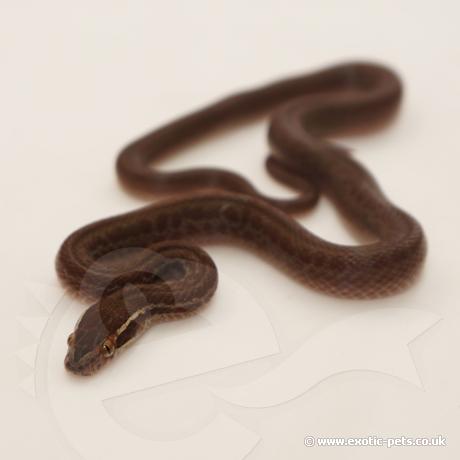

The African House Snake reaches an adult length of 60-120cm. They are a shade of brown with a pair of pale lines on either side of the head.
| Origin | Sub-Saharan Africa |
|---|---|
| Environment | Widespread |
| Adult Size | 2-4ft |
| Suitability | Beginner |
| Lifespan | 12 Years + |
| Temperament | Skittish |
African House Snakes are a medium-sized, slender pale brown snake with two white lines running along either side of their head. As babies, they tend to have more speckled markings running along their body but most do lose the patterning once fully grown. House Snakes that carry hets sometimes still have a spot like markings along the flanks of their body. Females are larger than the males and reach lengths around 90-120cm (3-4ft) whereas the males tend to grow around 60cm (2ft) long.
When it comes to handling African House Snakes do tend to be nervous, so it’s best to move slowly and calmly to get them used to being out. Babies can be a little nippy at first but with regular handling, they do tame down easily.
As their name suggests, African House Snakes originate from Africa specifically from Sub-Saharan African. They are very adaptable snakes and can be found living in burrows around woodland areas, as well as scrubland, savannah regions and also around human civilisations, which is how they became known as House Snakes.
African House Snakes are a really easy species to keep and can be housed well in a 3ft terrestrial vivarium. We always try to keep all our animals as natural as possible so we do recommend using more natural products and decor when designing any enclosure. Soil and sand-based mix can be used for substrate but as the substrate is dry we do recommend having a humid spot within the enclosure. This can be achieved but using a snake cave with moss inside or simply having a moss area on the cool side of the enclosure. This will help maintain humidity levels as well as help aid shedding. Alternatively if you want to go for a more basic looking enclosure you can use Lignocel or Aspen substrate, however, still, make sure to provide a humid spot.
Cork bark, tubes and branches will add enrichment for the snake to climb over along with artificial decor such as skulls, vines, trailing and standing plants.
The water bowl should be big enough so that the snake can submerge its self if it wants too. Make sure to provide fresh clean water on a daily basis and scrub the bowl at least a few times a week to prevent any bacteria build up around the bowl.
Heating the vivarium can be done via the use of a heat mat or heat bulb. Whichever you do decide to go for though ensure to connect your heat source to a thermostat to help control and manage the temperature. If you use a bulb in the enclosure we do advise having a heat guard around the bulb to prevent the snake from burning itself. When using heat mats inside the vivarium just have a thin layer of substrate on top no thicker than 1cm or alternatively, you can use a heat mat holder too. The basking area needs to reach 32C (90F), provide a cooler area of 21C (70F). During night, you can allow the temperatures to drop down at least 5C.
When it comes to feeding African House Snakes some can be fussy as babies and take a while to get feeding. Rest assured though, all our available snakes have a clean feeding record which can be provided upon purchase.
Babies should be fed every 5-7 days on defrost pinkie mice and moved up a size once the meal no longer leaves a bulge in the snakes stomach. Most adults tend not to take anything bigger than a large mouse. If you do need help choosing the right food for your snake though feel free to call for more advice.